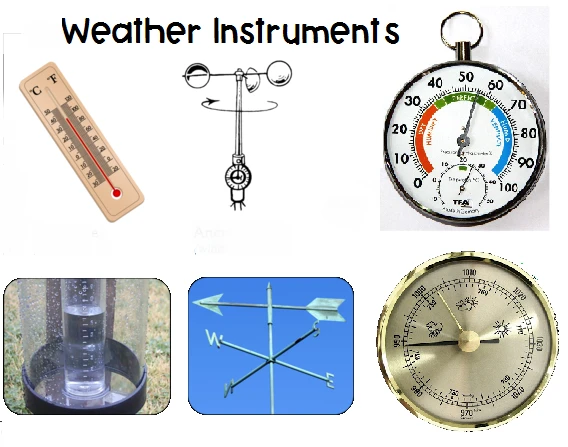
# Weather Instruments: Tools for Measuring Atmospheric Conditions
## Introduction to Weather Instruments
Weather instruments are essential tools used by meteorologists, scientists, and weather enthusiasts to measure various atmospheric conditions. These instruments provide accurate data that helps us understand weather patterns, predict changes, and prepare for potential weather-related events.
## Common Types of Weather Instruments
### 1. Thermometer
The thermometer is perhaps the most familiar weather instrument. It measures air temperature, typically in degrees Celsius or Fahrenheit. Modern thermometers use various technologies, including mercury, alcohol, or digital sensors.
### 2. Barometer
A barometer measures atmospheric pressure, which is crucial for weather forecasting. Changes in air pressure often indicate approaching weather systems. There are two main types: mercury barometers and aneroid barometers.
### 3. Hygrometer
This instrument measures humidity – the amount of water vapor in the air. Hygrometers help predict precipitation and are important for understanding comfort levels in different weather conditions.
### 4. Anemometer
Anemometers measure wind speed. The most common type has three or four cups that rotate with the wind, with the rotation speed corresponding to wind velocity. Some modern versions use ultrasonic technology.
### 5. Wind Vane
Also known as a weather vane, this instrument shows wind direction. It typically has an arrow that points into the wind, helping meteorologists understand weather system movements.
### 6. Rain Gauge
A rain gauge measures precipitation amounts over a set period. Simple versions are cylindrical containers with measurement markings, while more sophisticated models can record data electronically.
### 7. Pyranometer
This specialized instrument measures solar radiation. It’s particularly important for climate studies and solar energy applications.
## Advanced Weather Measurement Systems
Modern weather stations often combine multiple instruments into integrated systems. These automated weather stations can measure several parameters simultaneously and transmit data in real-time to weather monitoring networks.
Some advanced systems include:
– Doppler radar for tracking precipitation and storm systems
– Weather balloons (radiosondes) for upper-atmosphere measurements
– Satellite imaging systems for large-scale weather pattern observation
## Importance of Weather Instruments
Accurate weather data is vital for numerous applications:
– Agriculture: Farmers rely on weather forecasts for planting and harvesting
– Aviation: Pilots need precise weather information for flight safety
– Disaster preparedness: Early warning systems depend on accurate measurements
– Climate research: Long-term data helps scientists understand climate change
## Maintaining Weather Instruments
For accurate measurements, weather instruments require proper:
– Calibration to ensure precision
– Placement in appropriate locations (away from obstructions)
– Regular maintenance and cleaning
– Protection from extreme conditions when possible
## Conclusion
Weather instruments form the foundation of meteorological science. From simple thermometers to sophisticated satellite systems, these tools help us understand and predict atmospheric conditions that affect our daily lives. As technology advances, weather instruments continue to become more precise and capable, improving our ability to monitor and respond to weather phenomena.
Keyword: instruments of the weather
Comments are closed